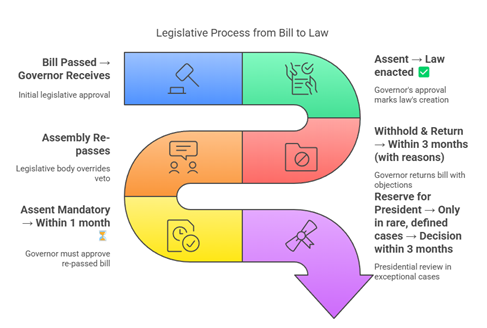THE CONTEXT: In a significant verdict, the Supreme Court invoked Article 142 of the Constitution to directly grant assent to 10 Bills that had been withheld by the Governor of Tamil Nadu. Alongside, the Court imposed a one-month timeline on the Governor to decide on Bills once they are re-presented after reconsideration—thus disallowing the “pocket veto” practice. This judgment fortifies federal principles and reiterates that the Governor, though appointed by the President, must largely act on the aid and advice of the State Council of Ministers, barring exceptional constitutional circumstances.
BACKGROUND AND CONSTITUTIONAL POSITION OF THE GOVERNOR
Appointment and Role of the Governor
-
- Constitutional Appointment: The Governor is appointed by the President as per Article 155 and holds office during the pleasure of the President (Article 156).
- Dual Role: While the Governor formally heads the state executive, Article 163 requires that their authority be exercised on the advice of the Council of Ministers, except in functions explicitly designated as discretionary by or under the Constitution.
Constituent Assembly debates reveal that the framers consciously chose to limit gubernatorial discretion, underscoring that the Governor is neither an independent power centre nor an appendage of the Union.
Relevant Constitutional Provisions
-
- Article 163: Mandates the Governor to act on the aid and advice of the Council of Ministers, barring rare discretionary scenarios.
- Article 200: Governs gubernatorial assent to state Bills, providing three formal courses of action:
1. Grant assent.
2. Withhold assent (return for reconsideration if it is not a Money Bill).
3. Reserve the Bill for the President’s consideration (only in specified instances, e.g., Bills affecting the High Court’s powers).
No Indefinite Delay: The Supreme Court has consistently held (e.g., State of Punjab vs Principal Secretary to the Governor of Punjab, 2023) that the Governor cannot withhold assent indefinitely without returning the Bill to the legislature—doing so violates the Constitution’s scheme of representative democracy.
Lacuna in the Constitution
-
- Article 200 uses the phrase “as soon as possible”, lacking an explicit timeline. Some Governors have interpreted this loosely, resulting in Bills languishing for extended periods.
- New SC Timeline: The Tamil Nadu judgment prescribes a one-month limit for gubernatorial action once the Bill is re-presented after reconsideration; if the Governor still finds issues, it must be justified and communicated to the Assembly.
THEORETICAL FRAMEWORK AND COMMISSION RECOMMENDATIONS
Sarkaria Commission (1988)
-
- Emphasized that gubernatorial discretion should be exercised sparingly, aligned with the constitutional design.
- Urged Governors to avoid political partisanship and follow the advice of the Council of Ministers in almost all matters.
Punchhi Commission (2010)
-
- Reiterated the importance of clear guidelines regarding the Governor’s role, particularly around discretionary powers and timelines for assent.
- Recommended steps to minimize friction between Raj Bhavan and the State government.
Shamsher Singh vs State of Punjab (1974)
-
- Held that the Governor’s discretionary powers are extremely limited; in the usual course, the Governor should act on ministerial advice.
- Established that real executive power lies with the Council of Ministers and not with the Governor.
KEY SUPREME COURT JUDGMENTS ON GOVERNOR’S DISCRETION
Rameshwar Prasad vs Union of India (2006)
-
- Asserted that subjective or partisan opinions by a Governor cannot justify President’s Rule under Article 356.
- Emphasized constitutional neutrality and underscored that actions of the Governor are open to judicial scrutiny.
Nabam Rebia and Bamang Felix vs Deputy Speaker (2016) – Arunachal Pradesh Case
-
- Held that summoning, proroguing, or dissolving the House must ordinarily be done on the advice of the Cabinet.
- Made clear that withholding assent indefinitely cannot be justified under the constitutional scheme.
Punjab Legislative Assembly Case (2023)
-
- Governor Banwarilal Purohit declined to summon the Budget Session, prompting the Supreme Court to clarify that an unelected head cannot stall lawmaking by an elected legislature.
- Reaffirmed that the Governor’s role is primarily ceremonial and facilitative rather than obstructive.
Tamil Nadu Assent Case (2025)
-
- The Court expanded upon previous rulings, imposing a strict timeline to prevent indefinite withholding of assent.
CURRENT SCENARIO IN VARIOUS STATES
Tamil Nadu
-
- Stalled Bills: Over 10 Bills, including those altering the Governor’s role in appointing Vice-Chancellors, delayed for prolonged periods.
- SC Verdict: Declared the withholding of assent unconstitutional; effectively “assented” to the Bills using Article 142.
Kerala
-
- Multiple Bills, including Lok Ayukta amendments, have reportedly been pending for up to two years.
- The state has approached the Supreme Court, citing parallels with the Tamil Nadu case.
Telangana
-
- 10+ Key Bills pending with Governor Tamilisai Soundararajan since September 2022.
- This standoff has triggered debates over the Governor’s constitutional obligations vs. political considerations.
Punjab
-
- Faced similar tussles with Governor Banwarilal Purohit regarding legislative sessions.
- The Supreme Court reiterated that while the Governor holds certain reserve powers, they cannot be wielded to indefinitely obstruct legislative proceedings.
- Exercised Article 142 to itself grant assent to 10 Bills stalled by the Governor’s inaction, marking a rare instance where the Court stepped into the domain of granting assent to ensure “complete justice.”

THE CHALLENGES
1. ‘Pocket Veto’ by Governors
-
- Unlimited inaction on Bills undercuts the legislative mandate of the elected government.
- Subverts democratic accountability and constitutional morality.
2. Politicization of the Governor’s Office
-
- Appointment by the Union Government often leads to tensions in states ruled by opposition parties.
- May escalate into constitutional stalemates, straining cooperative federalism.
3. Impact on Separation of Powers
-
- Excessive judicial intervention (e.g., deeming assent under Article 142) reflects systemic friction between the executive, legislature, and judiciary.
- While ensuring “complete justice,” it underscores the need for clearer constitutional or legislative prescriptions.
4. Frequent Litigation
-
- Multiple states have resorted to legal battles over delayed gubernatorial assent.
- Ideally, such disputes should be resolved administratively or politically, not always through the courts.
5. Administrative Logjam
-
- Delayed assent stifles governance—policies, budget provisions, and welfare measures remain stalled.
- Can erode public trust when key legislation (e.g., on public spending or social reforms) is held up.
SIGNIFICANCE OF THE SUPREME COURT VERDICT
1. Strengthening Constitutional Morality
-
- By prescribing time-bound action, the Court ensures the Governor’s constitutional duties are performed promptly.
- Reinforces the idea that constitutional offices must serve the public mandate, not partisan interests.
2. Reaffirmation of the ‘Aid and Advice’ Principle
-
- Declares that gubernatorial discretion is not absolute; it is circumscribed by ministerial advice under Article 163.
- Upholds the norm that the Governor’s role is facilitative in a parliamentary democracy.
3. Setting a Precedent
-
- The Tamil Nadu judgment offers a template for future cases where state Bills are indefinitely stalled.
- Likely to accelerate adjudication of similar disputes in Kerala, Telangana, and elsewhere.
4. Expansion of Judicial Oversight
-
- The Court’s use of Article 142 to directly grant assent underscores the judiciary’s willingness to rectify unconstitutional stalemates.
- Asserts that gubernatorial inaction cannot be shielded by personal immunity (Article 361), as actions are subject to judicial review.
THE WAY FORWARD:
1. Legislative/Constitutional Amendment
-
- Insert explicit timeframes (e.g., 1-2 months) in Article 200 or state laws, eliminating ambiguities like “as soon as possible.”
- Prevents Governors from delaying Bills indefinitely and strengthens legislative autonomy.
2. Revival of Commission Recommendations
-
- Sarkaria & Punchhi Commission suggestions on minimizing politicization of gubernatorial roles must be institutionalized.
- Could entail new protocols or guidelines clarifying the conditions and time limits for withholding assent.
3. Enhanced Cooperative Federalism
-
- Fostering regular communication between Raj Bhavan and the State Cabinet to resolve issues before they escalate.
- Utilizing forums like the Inter-State Council for better coordination and dispute resolution.
4. Ensuring a Neutral Governor’s Office
-
- The appointment process can incorporate neutrality and constitutional expertise as key criteria.
- Non-partisan conduct is crucial to uphold the spirit of democracy and maintain public trust.
5. Judicial Restraint with Clearer Statutory Framework
-
- While judicial intervention is crucial to safeguard constitutional values, frequent recourse to courts signals the need for clarified rules.
- Reinforces that governance should primarily operate through political and constitutional channels, rather than judicial mandates.
THE CONCLUSION:
The Supreme Court’s intervention in the Tamil Nadu Assent Case addresses a persistent constitutional concern—misuse of ambiguities in Article 200 for political ends. By setting firm timelines and even deeming Bills assented via Article 142, the Court protects the legislative prerogative of democratically elected governments. This verdict not only safeguards the federal spirit but also reminds all constitutional functionaries that power must be exercised in trust for the people.
UPSC PAST YEAR QUESTION:
Q. Whether the Supreme Court Judgement (July 2018) can settle the political tussle between the Lt. Governor and elected government of Delhi? Examine. 2018
MAINS PRACTICE QUESTION:
Q. Examine the constitutional lacunae in Article 200 and their impact on democratic law-making in States. How does the Supreme Court’s verdict of timelines address this gap?
SOURCE:
Spread the Word
